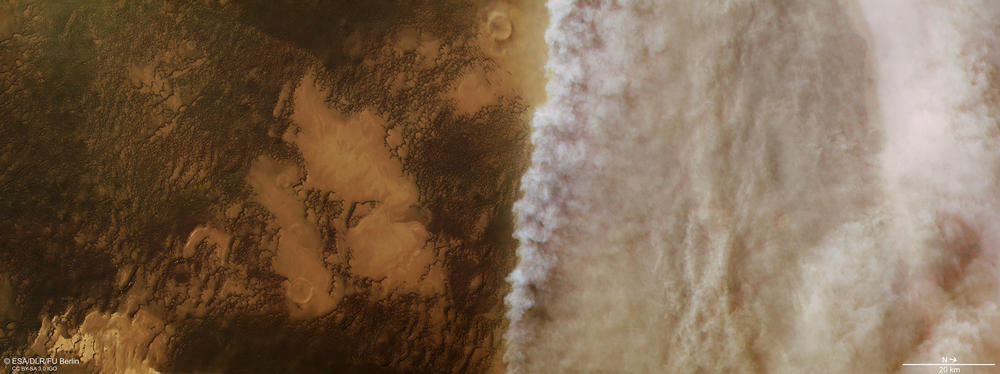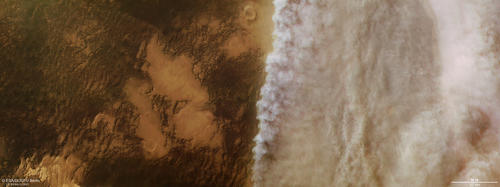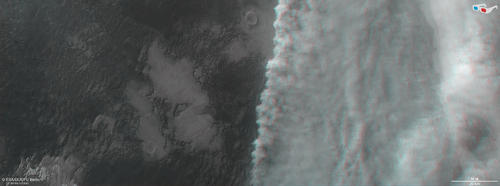Department of Earth Sciences
Service Navigation
Announcing this year's dust storm season on Mars
Images taken by the High Resolution Stereo Camera (HRSC) on board ESA’s Mars Express mission show a local dust storm with an upwelling front of dust clouds near the north-polar ice cap of Mars, its vertical structure nicely visible in the anaglyph image. This storm – imaged in April 2018 – is one out of several local dust storms that were observed on Mars during the last months.
The views shown here were created by the Planetary Sciences and Remote Sensing group at Freie Universität Berlin. The systematic processing of the HRSC image data was carried out at the DLR Institute of Planetary Research in Berlin-Adlershof.
» Read more about dust storms on Mars in the main article (below the gallery) ...
Color image - local dust storm front on Mars
HRSC color image
Image Credit: ESA/DLR/FU Berlin
Anaglyph - local dust storm front on Mars
HRSC anaglyph
Image Credit: ESA/DLR/FU Berlin
Main article 'dust storm season on Mars'
» Read more about the formation and observation of dust storms
Shown in this HRSC color image captured in April 2018 is a precursor of this year’s unusual intense dust storm season on Mars. This small-scale, local storm front is situated north of Utopia Planitia, in the vicinity of the north polar ice cap of Mars. Another, much larger storm emerged further southwest in Arabia Terra at the end of May, and developed into a global, planet-encircling dust storm event within several weeks. The latter is one of the most intense dust storms ever observed on Mars and is currently monitored by all five active ESA and NASA orbiters.
Local and regional dust storms often occur on Mars, but only few of them grow in size to become global phenomena that can last for months. This happens only every three to four Mars years, with one Mars year lasting about two Earth years. Although Martian dust storms are very impressive, due to Mars’ lower atmospheric pressure they are generally weaker compared to hurricanes on Earth, with less than half the typical hurricane wind speed.
Dust storms occur statistically more often in the northern autumn and winter season when Mars is around perihelion, which is the closest point to the sun. On its elliptical orbit around the sun Mars receives more sunlight at perihelion, so the atmosphere warms up which causes the air to move.
Previous massive dust storms were observed by NASA orbiters like Mariner 9 in 1971, Viking I in 1977, and by Mars Global Surveyor in 2001. The Mariner 9 dust storm experience was in particular remarkable, since upon arrival at Mars the probe transmitted only images that did not show any surface features – the planet was completely hulled in a dust storm. Only the summit of the 22 km high Olympus Mons peaked out of the clouds. When the storm calmed down, Mariner 9 mapped Mars globally for the first time.
Only very little sunlight reaches the Martian surface during the storm, such that the solar panels of NASA’s Opportunity rover cannot supply energy at the moment. Consequently, it went into sleep mode and stopped communicating in June 2018. At the same time, NASA’s Curiosity rover continues operating on the Martian surface and can observe the evolution of the storm, thanks to its nuclear-powered battery.
High Resolution Stereo Camera (HRSC)
Information to image origin and processing
The images were acquired by the HRSC (High Resolution Stereo Camera) on 3 April 2018 during Mars Express Orbit 18039. The ground resolution is approximately 16 meters per pixel and the images are centered at about 106° East and 78° North. The color image was created using data from the nadir channel, the field of view which is aligned perpendicular to the surface of Mars, and the color channels of the HRSC. The anaglyph, which provides a three-dimensional view of the landscape when viewed using red-green or red-blue glasses, was derived from data acquired by the nadir channel and the stereo channels.
Images: ESA/DLR/FU Berlin, CC BY-SA 3.0 IGO
Copyright Notice:
Where expressly stated, images are licenced under the Creative Commons Attribution-ShareAlike 3.0 IGO (CC BY-SA 3.0 IGO) licence. The user is allowed to reproduce, distribute, adapt, translate and publicly perform it, without explicit permission, provided that the content is accompanied by an acknowledgement that the source is credited as 'ESA/DLR/FU Berlin', a direct link to the licence text is provided and that it is clearly indicated if changes were made to the original content. Adaptation / translation / derivatives must be distributed under the same licence terms as this publication.
The High Resolution Stereo Camera was developed at the German Aerospace Center (DLR) and built in collaboration with partners in industry (EADS Astrium, Lewicki Microelectronic GmbH and Jena-Optronik GmbH). The science team, which is headed by Principal Investigator (PI) Prof. Dr. Ralf Jaumann, consists of 52 co-investigators from 34 institutions and 11 countries. The camera is operated by the DLR Institute of Planetary Research in Berlin-Adlershof.


